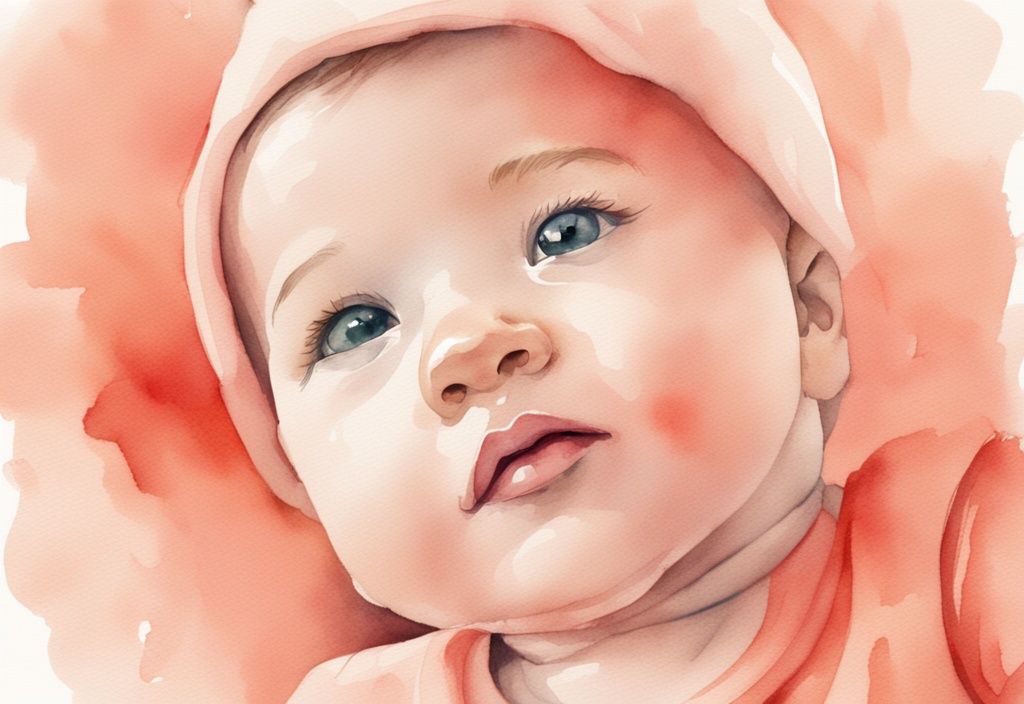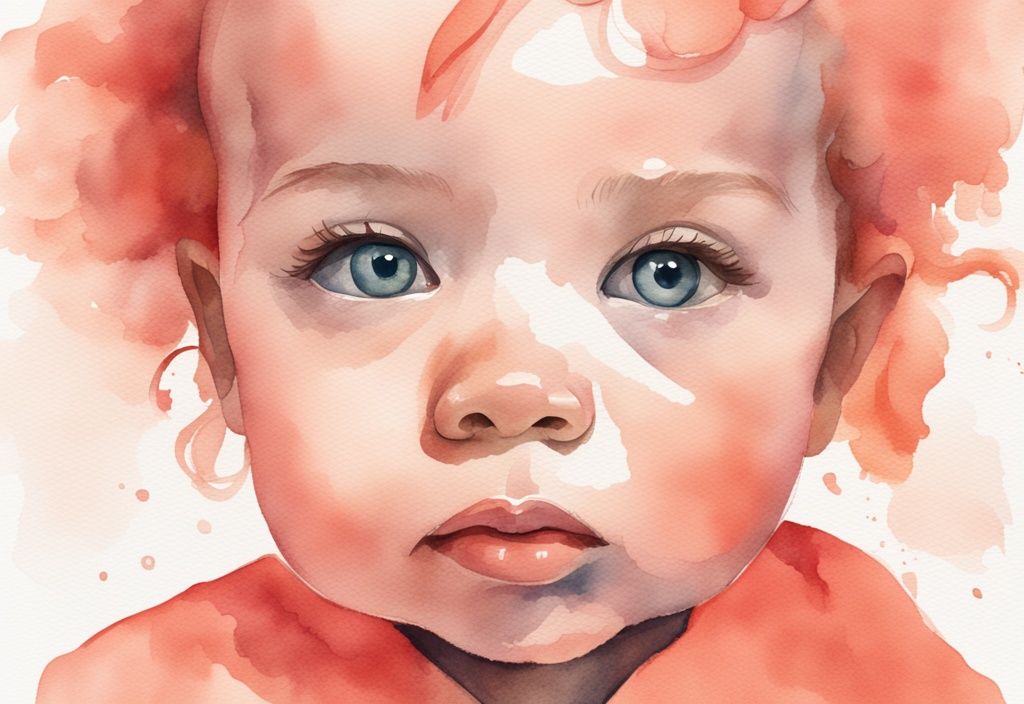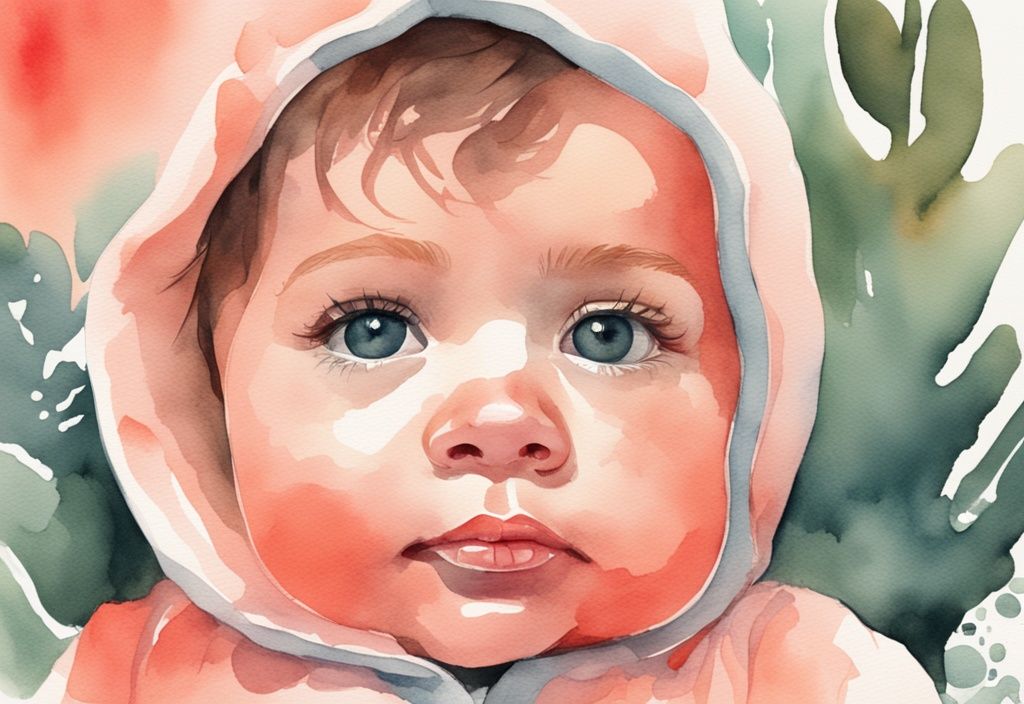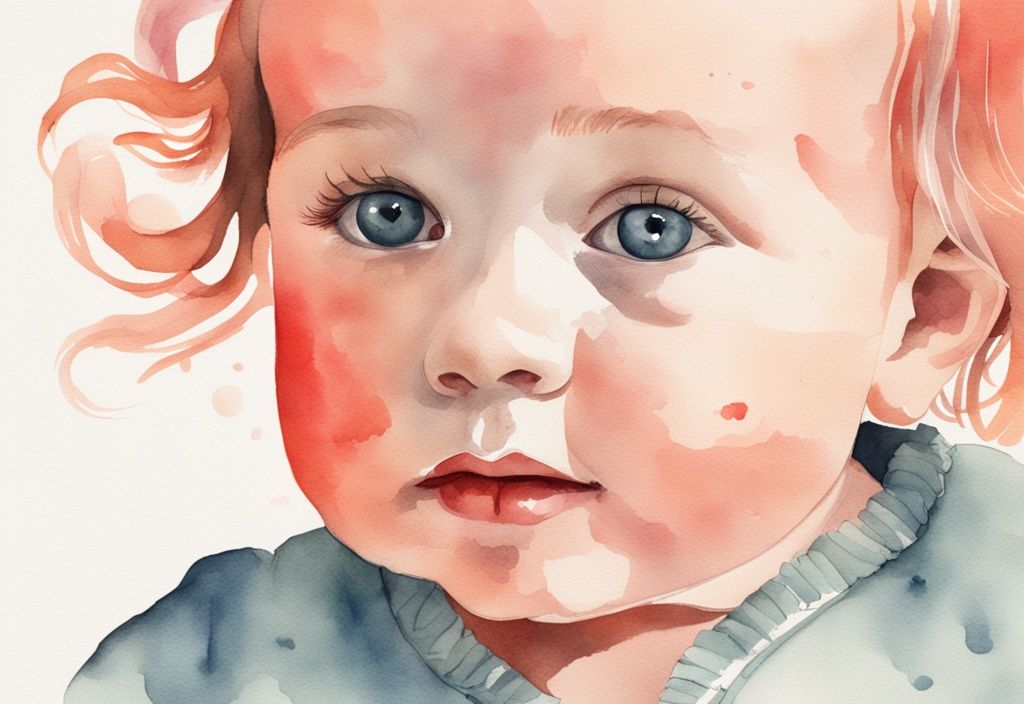Ever noticed a worrying redness around your baby’s eyes and wondered what could be causing it? You’re not alone. As a mom of two, I’ve been there, and I know how concerning it can be. From allergies to blocked tear ducts, several factors can lead to this common issue.
In this article, we’ll explore the potential causes of redness around a baby’s eyes, symptoms to watch for, and effective treatments. I’ll share some practical tips and insights I’ve picked up along my parenting journey to help soothe your little one’s discomfort.
So, take a deep breath, dear parent. Together, we’ll navigate this challenge and ensure your baby’s comfort and health. After all, understanding is the first step to effective care.
Identifying the Causes of Redness Around a Baby’s Eyes
When you notice redness around your little one’s eyes, it’s natural to feel a bit worried. Understanding the potential causes can help you navigate this common parenting challenge with confidence and care.
Common Causes: Conjunctivitis and Blocked Tear Ducts
One of the usual suspects behind that pesky redness is conjunctivitis, or as most of us call it, pink eye. It can be viral or bacterial, and while the viral type often resolves on its own, the bacterial kind might bring along some yellow discharge and require antibiotics. It’s like when your toddler gets a cold—sometimes it just needs time, but other times a little extra help is needed.
Another frequent cause is blocked tear ducts, especially in newborns. My own little ones went through this phase, and I remember the worry. But here’s the good news: it often clears up without any medical intervention. Just a bit of patience and gentle care, and you’ll likely see improvement.
Less Common Causes: Allergies, Birthmarks, and Serious Conditions
Allergies can also be a culprit, though they’re less common. Think about dust, mold, or even some of those baby lotions and shampoos we love to use. If your older infant seems to have red eyes, it might be time to consider what they’ve been exposed to lately.
And then there are those birthmarks, like the charmingly named “angel’s kiss.” They can cause redness but tend to fade as your baby grows. It’s just one of those quirks that come with being a parent, like finding cheerios in the oddest places.
However, it’s important to stay vigilant for more serious conditions. Things like corneal ulcers, periorbital cellulitis, and uveitis are rare but require immediate attention. If you ever feel unsure, trust your instincts and consult a healthcare professional. After all, you’re the expert on your baby, and your intuition is a powerful tool.
Recognizing Symptoms of Eye Redness in Babies
Understanding the signs of eye redness in your little one is crucial. From mild irritations to more concerning symptoms, knowing what to look for can help you take the right steps in caring for your baby’s eyes.
Signs of Eye Irritation: Watery Eyes, Swelling, and Itchiness
Oh, the joys of parenting! Sometimes, we notice redness around a baby’s eyes, and it can be quite worrisome. Often, this redness is accompanied by watery eyes, swelling, and itchiness. These signs are like little clues, hinting at eye irritation. It could be due to allergies or even a mild infection. Discharge and tearing might join the party, too, indicating potential irritation or infection.

If your baby has eczema, you might see the redness and swelling worsen, especially if they rub their eyes often. Keep an eye on these symptoms, as they can offer valuable insights into what’s causing the redness around your baby’s eyes. Remember, you’re not alone in this journey!
Severe Symptoms: Vision Problems and Pain
Now, let’s talk about when things get a bit more serious. If you notice vision problems, significant pain, or increased swelling, it’s time to take action. These symptoms could signal a more serious condition affecting your baby’s eyes. Light sensitivity and fever are like little red flags, waving for urgent medical evaluation.
Early intervention is key to keeping your baby’s eyes healthy. So, if you spot these severe symptoms, don’t hesitate to seek professional advice. You’re doing an amazing job, and being vigilant is part of the journey. Remember, you’re part of a community of parents navigating the ups and downs of baby care together!
When and Why to Seek Medical Attention
Redness around a baby’s eyes can be a common concern for parents, but sometimes it signals something more serious. It’s important to know when to seek medical attention to ensure your little one’s health and well-being. In this section, we’ll explore the warning signs you shouldn’t ignore and discuss eye infections in newborns, helping you feel confident in caring for your baby’s precious eyes.
Warning Signs of Serious Conditions
Redness around a baby’s eyes can sometimes indicate more serious underlying conditions that require prompt medical attention. Parents should be vigilant for warning signs such as severe pain, noticeable changes in vision, persistent redness, and fever. These symptoms may suggest a more serious issue that needs immediate evaluation by a healthcare professional.
Additionally, if there is any discharge from the eyes, particularly if it is thick or yellow, it could indicate a bacterial infection that necessitates antibiotic treatment. In cases where red flags or vision concerns are present, an urgent referral to an ophthalmologist is strongly recommended to prevent potential complications and ensure the baby’s eye health is properly managed.
Eye Infections in Newborns: When to Worry
Newborns are particularly susceptible to eye infections, often contracted from bacteria during the birthing process. It is crucial for parents to seek immediate medical treatment if they observe symptoms such as redness, pus discharge, or swollen eyelids, as these could indicate a serious infection.
To mitigate the risk of such infections, preventive antibiotic eye drops are typically administered to newborns shortly after birth. These measures are essential to protect the delicate eyes of newborns and to prevent any long-term complications that could arise from untreated infections. Parents should remain alert and consult healthcare providers promptly if any concerning symptoms develop.
How Doctors Diagnose the Cause of Redness Around a Baby’s Eyes
When your little one has redness around their eyes, it can be both puzzling and concerning. Understanding how doctors get to the root of the issue can provide some peace of mind. They use a combination of physical examinations and diagnostic tests to uncover what’s really going on.

What to Expect During a Physical Examination
When you visit the doctor for redness around your baby’s eyes, they’ll start by gathering a comprehensive history and conducting a physical examination. This step is crucial in distinguishing between harmless and more serious causes. During the check-up, the doctor will look for any discharge, swelling, or unusual pupil reactions. These observations are like little clues that help piece together the puzzle of your baby’s eye redness. If your child is a bit older and able to cooperate, the doctor might gently flip the eyelid—a technique known as lid eversion—to check for any tiny foreign bodies causing irritation. It’s all part of ensuring your baby gets the right diagnosis and treatment.
Understanding Diagnostic Tests
Diagnostic tests are another essential tool in solving the mystery of redness around a baby’s eyes. One common test involves using fluorescein drops, which can highlight corneal staining. This staining might indicate trauma or foreign bodies on the eye’s surface. Additionally, an unusual red reflex during an eye exam could point to more serious conditions, like corneal scarring, cataracts, or retinal issues. These tests are carefully chosen based on what’s suspected and how severe the symptoms are, ensuring your baby receives the best care possible.
Effective Treatments for Redness Around a Baby’s Eyes
Redness around a baby’s eyes can be concerning for any parent. From home remedies to medical treatments, there are various ways to address this issue and keep your little one’s eyes healthy and comfortable. Let’s explore some practical solutions that can help.
Home Remedies and Over-the-Counter Solutions
As a mom, I know how important it is to start with gentle and safe methods. One simple approach is a gentle massage around your baby’s eye area. This can help clear blocked tear ducts, which is a common issue in infants. It’s like giving your baby a tiny spa day, encouraging natural drainage of tears and reducing redness.
Another trusty remedy is applying cool compresses. These can be a lifesaver for soothing swelling and itchiness caused by irritants or allergies. Just imagine the relief of a cool breeze on a hot day—these compresses offer similar comfort by calming the inflamed area.
For those dealing with allergy-related redness, over-the-counter antihistamine drops might be your new best friend. These drops work wonders by counteracting the body’s allergic response, providing a practical solution for managing mild eye irritation. It’s like having a little superhero in a bottle!
Medical Treatments: Medications and Preventive Measures
Sometimes, redness around a baby’s eyes can be due to bacterial infections, and that’s when a doctor’s visit becomes essential. Doctors often prescribe antibiotic drops or ointments to tackle the infection head-on. These medications target the bacteria directly, reducing symptoms and preventing further complications. It’s like having a tiny army fighting off the bad guys!
For both bacterial and viral conjunctivitis, warm compresses can be a comforting addition to the treatment plan. They promote circulation and soothe the affected area, much like a warm hug for your baby’s eyes.
Preventive measures are key to maintaining eye health. Keeping your environment clean and avoiding known allergens are crucial steps in preventing future episodes of redness. By doing so, you help ensure your baby’s eyes remain healthy and irritation-free. Remember, it’s all about creating a safe and cozy space for your little one to thrive.
FAQ: Your Questions About Baby Eye Redness Answered
Baby eye redness can be concerning, but understanding its causes and treatments can help ease your worries. Let’s dive into some common questions parents have about redness around a baby’s eyes and explore practical solutions together.

What are the main causes of redness around a baby’s eyes?
Redness around a baby’s eyes can be a bit alarming, but knowing the usual culprits can bring some peace of mind. Often, it’s caused by conjunctivitis (or pink eye), which can be either viral or bacterial. Then there are blocked tear ducts, a common issue in infants that usually resolves on its own. Don’t forget about allergies and irritants like dust, mold, or even some hygiene products, which can also lead to those red, puffy eyes.
How can I treat my baby’s eye redness at home?
When it comes to soothing your little one’s red eyes at home, a gentle touch goes a long way. Try softly massaging the tear ducts and applying cool compresses to help reduce swelling. It’s also wise to steer clear of known irritants. These simple steps can work wonders, especially for blocked tear ducts and minor irritations. Remember, you’re doing great!
When should I take my baby to the doctor for red eyes?
Trust your instincts, and if you notice severe symptoms, thick discharge, or persistent redness, it’s time to call the doctor. Getting professional advice ensures the right diagnosis and treatment, keeping those precious eyes healthy and happy.
Are eye infections in babies serious?
Most eye infections in babies aren’t too serious, but it’s always better to be safe than sorry. Some infections, especially those picked up during birth, need prompt treatment to avoid complications. Early intervention is key to keeping your baby’s eyes and overall health in tip-top shape.
Can allergies cause redness around a baby’s eyes?
Oh yes, allergies can definitely be the culprit behind the redness around your baby’s eyes. Dust, mold, or even certain products can trigger irritation. By identifying and avoiding these allergens, you can help manage the symptoms and reduce the chances of that pesky redness making a comeback.
Conclusion
Oh, the worries we parents face! Redness around a baby’s eyes can be a bit unsettling, can’t it? But, let me assure you, it’s often not as scary as it seems. Most of the time, it’s just a little irritation or a minor infection that’s easily managed with some tender care. Knowing the usual culprits, like conjunctivitis or those pesky blocked tear ducts, can really help us tackle the issue head-on.
Keep an eye on those symptoms, though! If the redness sticks around or you notice anything more serious, like discharge or vision troubles, it’s time to get some professional advice. We want to nip any potential problems in the bud and keep our little ones safe and sound.
And let’s not forget those regular pediatric check-ups. They’re like a wellness tune-up for your baby’s eyes, ensuring everything is developing just right. These visits are a great opportunity to catch any concerns early and keep your baby’s eyes bright and healthy.
Remember, parenting is a journey, and we’re all in this together. With a little knowledge and a lot of love, we can keep those adorable eyes sparkling!


